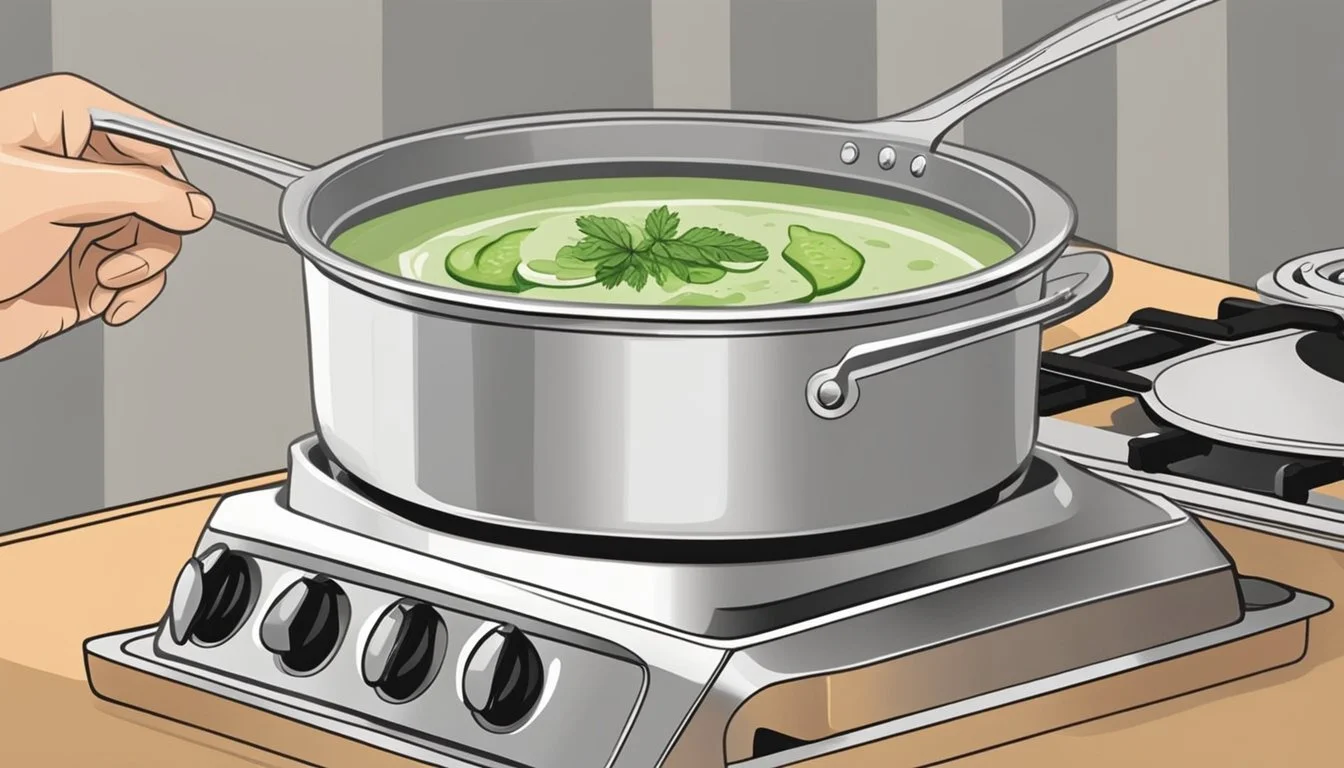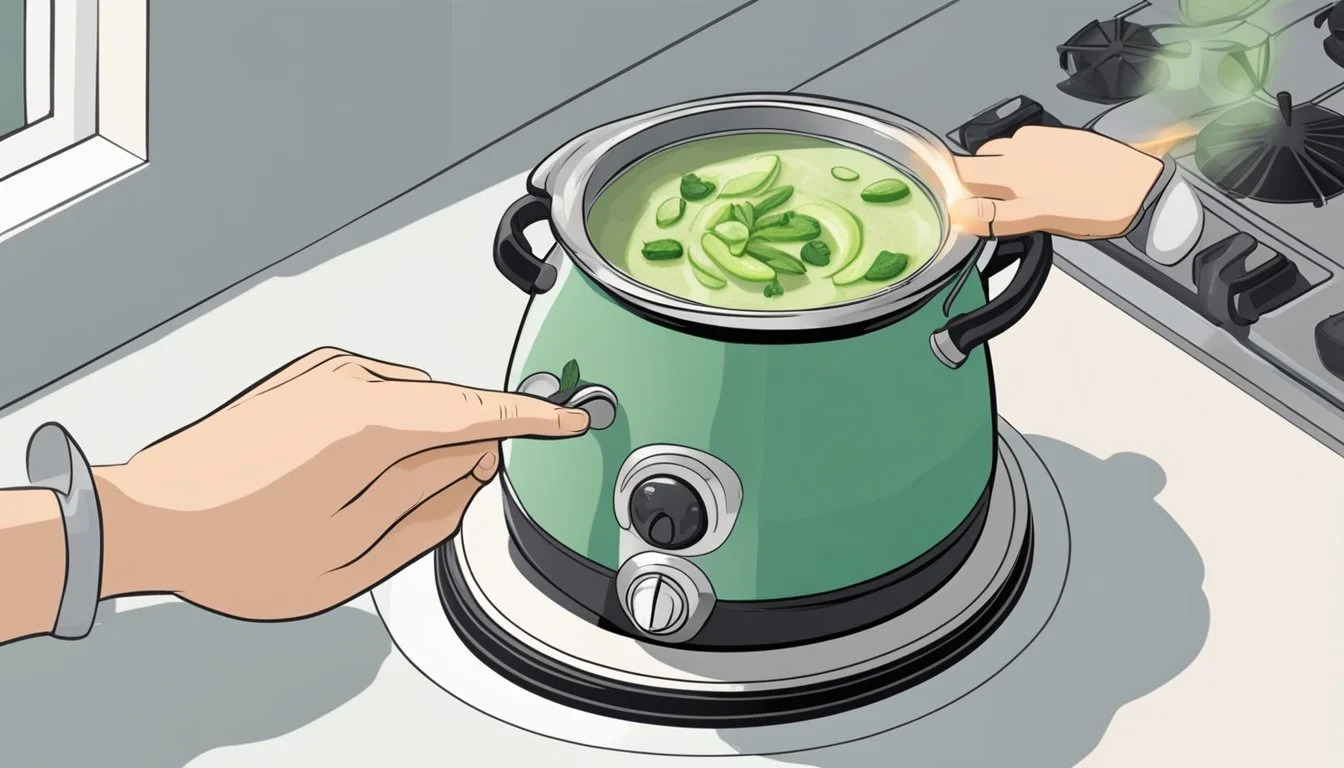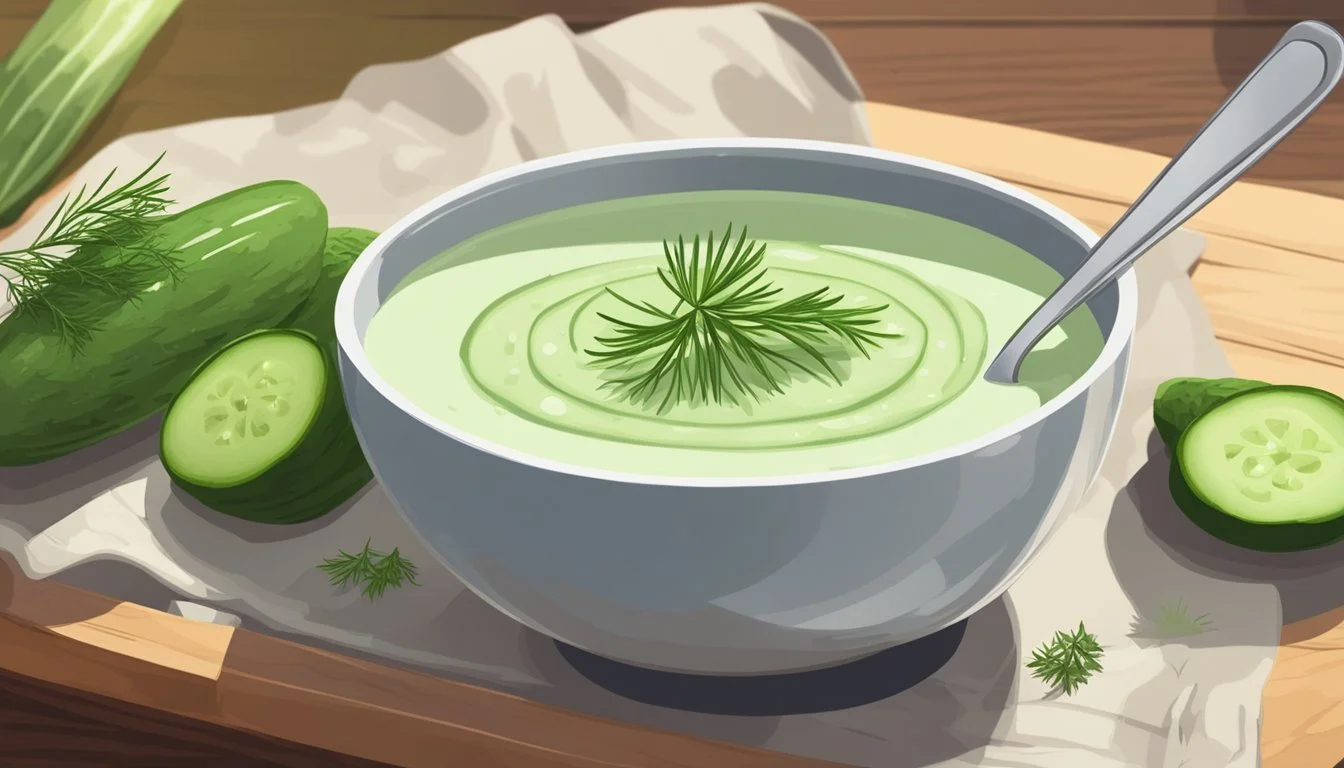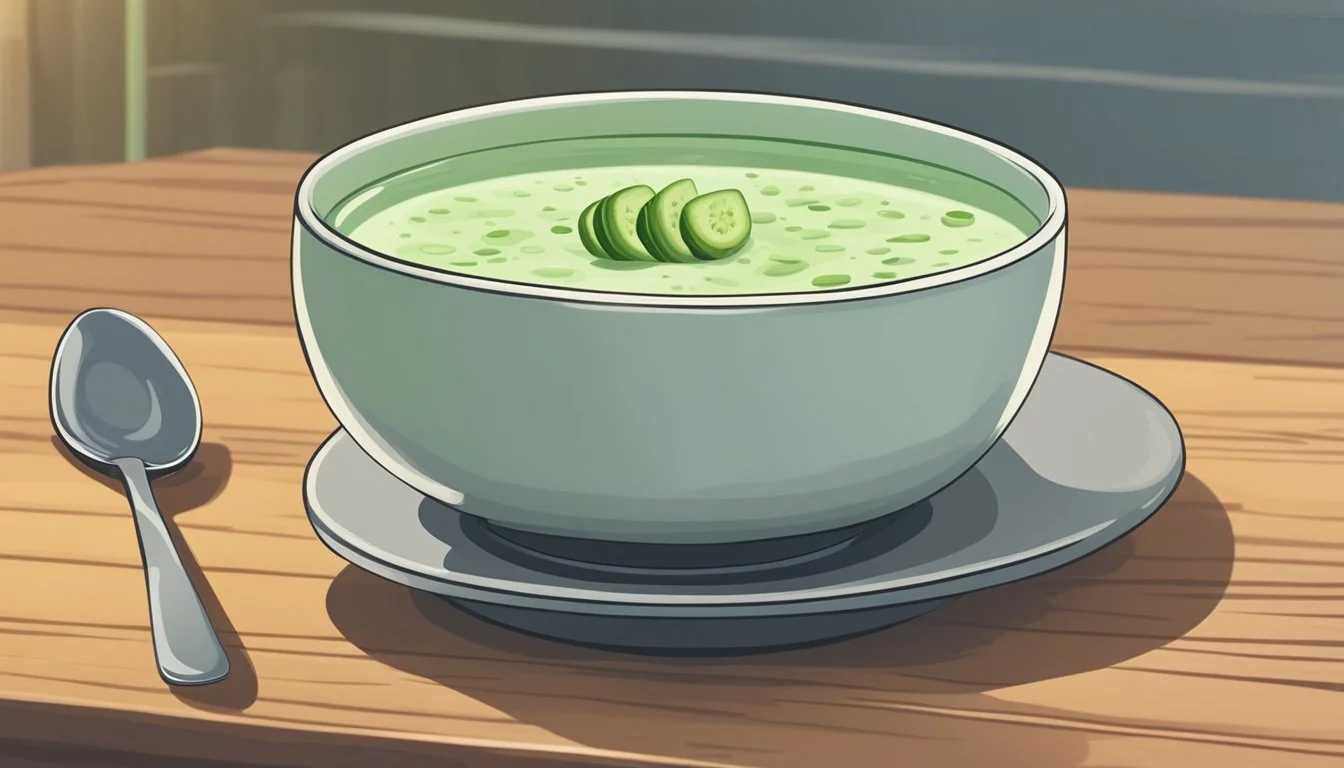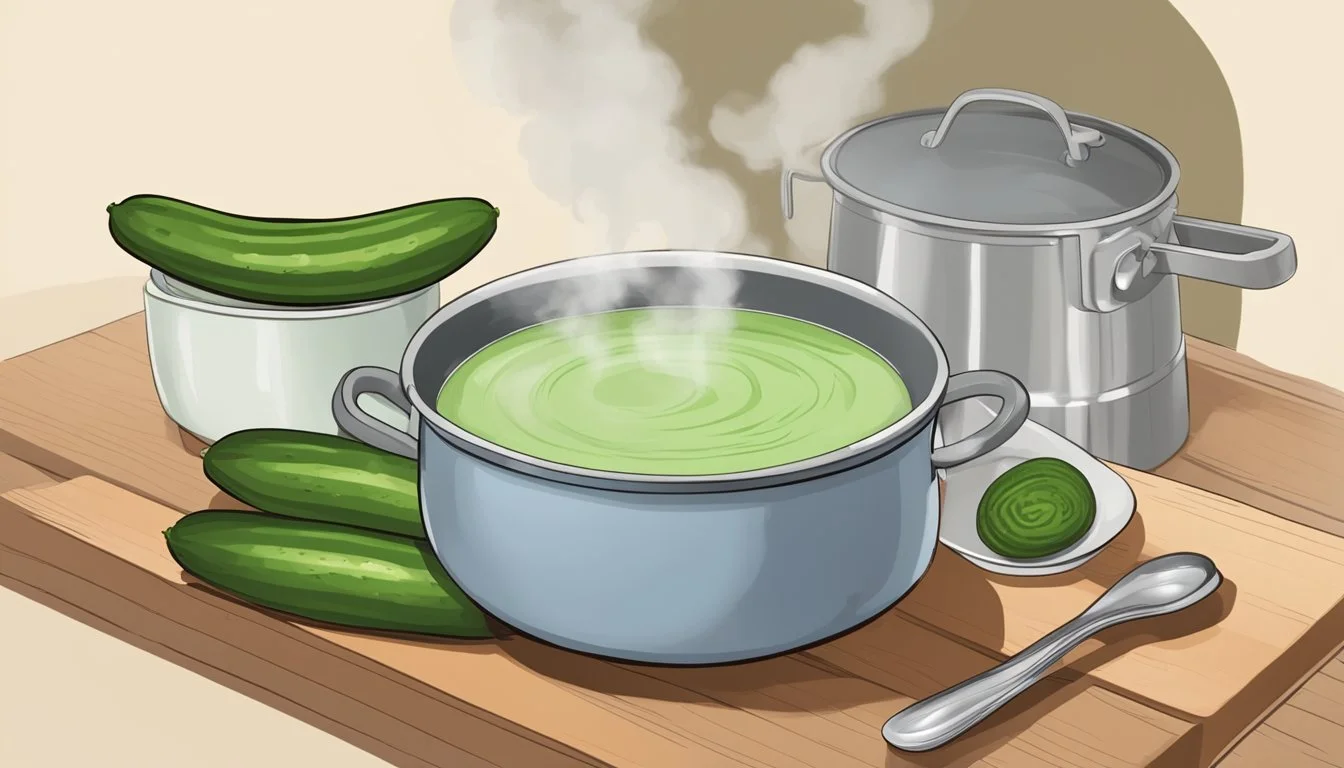How to Reheat Chilled Cucumber Soup
Expert Tips for Perfect Results
Chilled cucumber soup is a refreshing and light starter, perfect for hot summer days. This crisp and cool dish is made from cucumbers, yogurt, and fresh herbs, creating a blend that is both delicious and nutritious. Sometimes, a batch of cucumber soup can be too large to consume in one sitting, leading to leftovers that need reheating.
To reheat chilled cucumber soup, start by placing it in a saucepan and warming it over low heat, stirring occasionally to ensure even heating. This method preserves the delicate flavors and maintains its creamy texture, unlike microwaves which can heat unevenly and curdle the ingredients. Additionally, using a gentle heat prevents the soup from losing its fresh taste and aroma.
For those who have frozen cucumber soup, thaw it in the refrigerator overnight before reheating it gently on the stove. This approach allows the soup to return to its optimal texture and flavor. Whether straight from the fridge or freezer, reheating cucumber soup correctly ensures that it remains a delightful and refreshing dish, perfect as a summer starter.
Overview of Chilled Cucumber Soup
Chilled cucumber soup is a refreshing and light dish perfect for warm weather. It's often made with a blend of cucumbers, yogurt, and a variety of herbs. The key ingredients include cucumbers, Greek yogurt, garlic, lemon, and dill.
This type of soup is typically cold, making it a great choice for summer meals or as a starter.
Ingredients often seen in chilled cucumber soup include:
Cucumbers
Greek yogurt or plain yogurt
Garlic
Lemon juice
Dill and other herbs
Garnishes like chopped herbs or cucumber slices add an extra layer of flavor and eye appeal.
The preparation involves blending the cucumbers with yogurt and other ingredients to achieve a smooth, creamy texture. Seasonings such as salt, pepper, and sometimes sumac are added to enhance flavor.
It's common to chill the soup for at least an hour before serving. This allows the flavors to meld together and the soup to achieve the desired cold temperature.
Garnishing with fresh herbs, cucumber slices, or a sprinkle of sumac provides a visually appealing and tasty finish.
Chilled cucumber soup offers a balance of tangy, savory, and fresh flavors, thanks to the combination of yogurt, cucumbers, and herbs.
Selecting Quality Ingredients
Choosing high-quality ingredients is crucial for the best flavor in chilled cucumber soup.
English Cucumbers: Opt for English cucumbers for their sweetness and fewer seeds. They have thin skins, which add texture without bitterness.
Lemon Cucumbers: These offer a unique citrus note. They are round and yellow, providing an interesting aesthetic and flavor.
Organic Produce: Whenever possible, select organic cucumbers to avoid pesticides. Organic ingredients tend to bring out a cleaner, fresher taste.
Fresh Herbs: Basil, dill, and mint are excellent options. Fresh herbs enhance the soup's fragrance and provide a burst of flavor.
Dairy: Use high-quality yogurt or buttermilk to give the soup a creamy texture. Organic dairy products tend to be richer and provide better taste.
Olive Oil: A drizzle of extra virgin olive oil can add depth. Choose olive oil with a fruity and peppery profile for the best results.
Investing in quality ingredients elevates a simple chilled cucumber soup, making it a refreshing and delightful dish.
Equipment Needed
To successfully reheat chilled cucumber soup while preserving its texture and flavor, having the right equipment is essential. Below, the specific tools and their critical roles are discussed.
Using a Blender for Smooth Texture
A blender is crucial for achieving a perfectly smooth texture when dealing with cucumber soup. By blending the soup, you can combine ingredients evenly, particularly if the soup separates during reheating.
Blenders can vary in power; a high-powered model ensures a consistently smooth mixture. Always start blending on low speed and gradually increase to achieve the desired consistency without splattering.
Ensure to follow safety protocols by securing the lid firmly to prevent spills. Additionally, using a blender can help re-emulsify the soup if oil or other ingredients separate, maintaining a uniform texture and taste.
Food Processor as an Alternative
If a blender is not available, a food processor can serve as an effective alternative. It also helps in maintaining a consistent texture and ensures the ingredients are well-mixed.
Using a food processor involves similar steps to a blender: start on a low speed and increase gradually. It's important to note that food processors typically have larger bases and might require careful monitoring to avoid over-processing, which can make the soup too thin.
Equivalent to blenders, securing the lid properly before starting is essential to avoid accidents. Food processors might not achieve the ultra-smooth consistency of high-speed blenders but will still provide a satisfactory texture.
Preparing the Soup
Properly preparing cucumber soup is essential for achieving a creamy and refreshing dish. This process involves blending cucumbers, incorporating yogurts and herbs, and seasoning to taste.
Blending Cucumbers for Base
Peel and seed fresh cucumbers. Roughly chop them into pieces that fit easily into a blender. Using a high-powered blender, process the cucumbers until they reach a smooth consistency.
Adding some diced onion and a handful of fresh dill can enhance the base flavor. Pulse the mixture until everything is integrated. A touch of lemon juice can brighten the flavor, giving the soup a slightly tangy kick.
Incorporating Yogurts and Herbs
Use Greek yogurt or plain yogurt to achieve a creamy texture. Whisk the yogurt with iced water until smooth.
Fold in finely chopped herbs like mint and basil, which contribute to the soup's freshness. Raisins and toasted walnuts can be added for an interesting texture and taste. Ensure the yogurt is well-integrated with the cucumber mixture before moving to the seasoning step.
Seasoning to Taste
Season the soup with salt and pepper to enhance the flavors. Opt for sea salt or kosher salt for the best taste.
Adjust the seasonings by adding more salt or pepper if necessary. Sprinkle a bit of sumac for a hint of tanginess, which complements the cucumber and yogurt. If the soup lacks brightness, a bit more lemon juice can be added. Always taste and adjust until the balance is perfect.
Refinement and Flavor Enhancement
Reheating chilled cucumber soup can alter its texture and flavor. Attention to detail can help restore and even enhance its qualities.
To add freshness, consider topping the soup with finely chopped fresh dill or chives. These herbs impart a bright, vibrant flavor.
Adding a drizzle of olive oil can enrich the soup's smoothness. A swirl of honey will also introduce a subtle sweetness that complements the crispness of the cucumber.
Citrus elements like lemon or lime add a zesty note. A squeeze of fresh lemon or lime juice can elevate the overall taste. This is especially effective when the soup may feel slightly flat after reheating.
Using finely chopped shallots can add a mild onion flavor without overpowering the soup. Shallots blend in well, adding complexity and a mild crunch.
For an extra touch, garnish with thin slices of cucumber to provide a fresh, crunchy texture contrast. These simple adjustments can significantly uplift the taste and presentation of reheated cucumber soup.
Proper Soup Storage
To ensure the freshness of chilled cucumber soup, proper storage is vital. Always transfer the soup to an airtight container. This minimizes exposure to air and helps retain the soup's flavor and texture.
Place the container in the refrigerator promptly after preparation or cooling. Cucumber soup should be stored in the fridge and consumed within 3-4 days for the best taste.
For longer storage, consider freezing the soup. Before doing so, make sure the soup has cooled to room temperature. Pour it into airtight containers or freezer-safe bags. Leave some space at the top, as the liquid expands when frozen.
To prevent freezer burn, ensure the container is sealed tightly and remove as much air as possible. Label the container with the date of freezing to keep track.
When ready to reheat, first defrost the soup in the fridge overnight if it was frozen. This gradual thawing helps maintain its quality.
Serving Suggestions and Pairings
Selecting the right bowls and utensils can enhance the dining experience, while complementary sides and dishes add variety and flavor to the meal.
Choosing the Right Bowls and Utensils
Using the appropriate bowls and utensils adds to the presentation and enjoyment of chilled cucumber soup. Shallow bowls or wide-brimmed soup plates work best, allowing the soup to stay cool and visually appealing.
Porcelain and glass bowls are ideal for highlighting the soup's fresh, green color.
Utensils: Serve with a medium-sized spoon to balance each mouthful. For a touch of elegance, choose polished stainless steel or silver cutlery.
Presentation: Garnish with fresh dill or a swirl of yogurt to add a striking visual contrast. Adorn with a thin slice of avocado or a sprinkle of finely chopped chives for added texture and flavor.
Complementary Sides and Dishes
Pairing chilled cucumber soup with the right sides can elevate the meal. A crusty bread, such as a freshly toasted baguette or garlic bread, offers a satisfying contrast to the cool, smooth soup.
Consider small appetizers like crostini topped with a light tomato-and-basil mixture or a dollop of tzatziki.
Salads: Light, crisp salads complement the freshness of cucumber soup. A simple tomato and mozzarella Caprese or a mixed greens salad with a vinaigrette dressing works well.
For a heartier option: grilled chicken or shrimp makes an excellent accompaniment, providing protein while maintaining the meal's fresh and light theme.
Seasonal fruits: A small side of tart, sliced fruits like kiwi or grapefruit can refresh the palate between bites of soup.
Experimenting with these pairings can create a balanced and memorable dining experience.
Adjusting Soup Consistency
Adjusting the consistency of chilled cucumber soup can elevate its texture and flavor.
To make the soup thinner, add a small amount of milk or ice water. This can be done gradually until the desired consistency is achieved.
For a creamier texture, incorporate more yogurt or sour cream. Blend well after each addition to ensure smoothness.
Stirring the soup thoroughly helps distribute the added ingredients evenly. Using a hand blender can make this process easier.
If the soup seems too thick, a helpful table to guide adjustments might be:
Issue Solution Too thick Add milk or ice water Not creamy Add yogurt or sour cream
Taste the soup after each adjustment and modify seasonings if necessary. Small changes can make a big difference in the overall texture and flavor.
Consider chilling the soup again if you add liquids to ensure it maintains the right temperature before serving.
Cuisine Variations
Mediterranean-style cucumber soup often features yogurt as a base, combined with chopped cucumbers and fresh herbs like dill and mint. This variation may include garnishes like toasted walnuts and raisins to add texture and sweetness.
Traditional cucumber soup typically sticks to basic ingredients such as cucumber, yogurt, and sometimes sour cream. Seasoning is kept simple with just salt, pepper, and dill, highlighting the freshness of cucumbers.
Middle Eastern variations may add ingredients such as sumac and toasted nuts. The use of heavy cream or coconut milk can be common in these recipes, providing a richer texture that contrasts with the coolness of the cucumber.
Cuisine Key Ingredients Notable Additions Mediterranean Yogurt, cucumbers, mint, dill Toasted walnuts, raisins, sumac Traditional Cucumber, yogurt, sour cream, dill Salt and pepper Middle Eastern Cucumber, yogurt, heavy cream or coconut milk, sumac Toasted nuts
These variations highlight the versatility of cucumber soup, making it a refreshing dish adaptable to multiple culinary traditions.
Health Benefits and Dietary Considerations
Chilled cucumber soup is not only refreshing but also offers various health benefits.
Cucumbers are low in calories and contain important nutrients like vitamins K, C, and several B vitamins. They also have antioxidants that can help reduce inflammation.
For those looking for a gluten-free option, cucumber soup fits the bill since it does not contain any wheat-based ingredients.
When made with plain Greek yogurt, the soup becomes a good source of probiotics. These beneficial bacteria promote gut health and improve digestion.
The inclusion of Greek yogurt also adds protein to the soup. This can be particularly beneficial for those looking to maintain or build muscle mass. It also helps keep you fuller for longer periods.
The soup generally has low amounts of fat, especially if made without heavy creams. Substituting with options like coconut milk can also keep it low in fat while still maintaining a creamy texture.
Dietary flexibility is another advantage. Adjusting the ingredients makes it easy to cater to different dietary preferences or restrictions. For example, using dairy-free alternatives can make the soup suitable for vegans.
Nutritional Snapshot per Serving
Nutrient Amount Calories Approximately 60-100 calories Protein 5-8 grams (with Greek yogurt) Fat 2-5 grams Carbohydrates 10-15 grams
In summary, chilled cucumber soup offers a nutritious and versatile addition to various diets, providing benefits ranging from low calorie intake to improved gut health through probiotics.
Troubleshooting Common Issues
1. Soup Too Watery: If the reheated cucumber yogurt soup turns out too watery, it might be due to excess condensation. To fix this, strain the soup or add a pureed cucumber to thicken it.
2. Loss of Flavor: Sometimes, chilled cucumber soup might lose its vibrant taste upon reheating. This can be remedied by adding fresh seasoning such as salt, pepper, or a splash of lemon juice.
3. Uneven Heating: For even heating, use a microwave-safe bowl and cover it with a lid or splatter guard. Stir the soup frequently, ideally every 30 seconds, to distribute heat evenly.
4. Curled Texture: High heat can cause the yogurt in the soup to curl or separate. Heat on low settings and stir constantly to maintain a smooth, creamy texture.
5. Stovetop Reheating: When reheating on the stovetop, use low heat and stir regularly. This method ensures a smooth and even reheat without compromising the clean and clear flavors of the soup.
6. Overpowering Red Onion: Sometimes, the sharp flavor of red onion can become more intense after reheating. To mitigate this, add more cucumber or a touch of yogurt to balance the flavors.
7. Preservation of Freshness: Reheated cucumber soup may lack the refreshing quality of its chilled counterpart. Enhance its crispness by adding fresh dill, parsley, or a few slices of raw cucumber before serving.
Keep these tips in mind to ensure the cucumber soup remains a delightful summer meal or a light lunch, even when reheated.
Refreshing Variants to Try
Different variations of chilled cucumber soup can add exciting flavors and unique twists to your dish. From the zesty mint and lime fusion to the spicy bell peppers twist, these variants will bring a fresh and invigorating taste.
Mint and Lime Fusion
For a refreshing and zesty version, add mint and lime. Start with a traditional chilled cucumber soup base, then mix in finely chopped mint leaves. The mint provides a cooling effect that complements the cucumber.
Next, squeeze fresh lime juice into the soup. Lime adds a tangy note that lifts the flavors. To enhance the presentation, garnish with a slice of lime and additional mint leaves. This variant pairs well with summer meals and outdoor gatherings.
Spicy Bell Peppers Twist
Adding spicy bell peppers brings a flavorful kick to traditional cucumber soup. Begin by dicing red or yellow bell peppers finely. These peppers not only add spice but also a vibrant color contrast.
Incorporate diced cucumber into the mixture for added texture. Consider adding a dash of lemon juice to balance the spice with a bit of acidity. For an extra layer of flavor, sprinkle some chopped cilantro on top.
This spicy twist offers a bold alternative to the classic chilled cucumber gazpacho, making it perfect for those who enjoy a bit of heat in their dishes.
Final Thoughts on Chilled Cucumber Soup
Chilled cucumber soup serves as a refreshing option for a light dinner. Its cool, creamy texture and delicate flavors make it a popular choice, especially during warmer months. The combination of yogurt, cucumber, and fresh herbs provides a balance of tanginess and crunch.
Doogh, a traditional Persian yogurt-based drink, shares similarities with chilled cucumber soup. Both incorporate yogurt and are enjoyed cold. They offer a hydrating and flavorful experience, perfect for summer meals.
When reheating chilled cucumber soup, it's essential to avoid overheating, which can impact the soup's texture and flavor. Use gentle heat and stir regularly to ensure even warming without compromising the dish's integrity.
For a cold cucumber soup, freshly prepared herbs like dill, parsley, and mint enhance the flavor. Garnishing with crushed red pepper flakes or sumac adds a touch of spice and visual appeal.
Chilled soups like this one can be a versatile addition to your meal repertoire. They can be served as a standalone appetizer or paired with a more substantial dish like avocado toast. Their simplicity and ease of preparation make them an excellent choice for busy days.
To keep the soup fresh, store it in the refrigerator in an airtight container. Proper storage helps maintain its flavor and texture, ensuring it stays enjoyable until the last spoonful.



